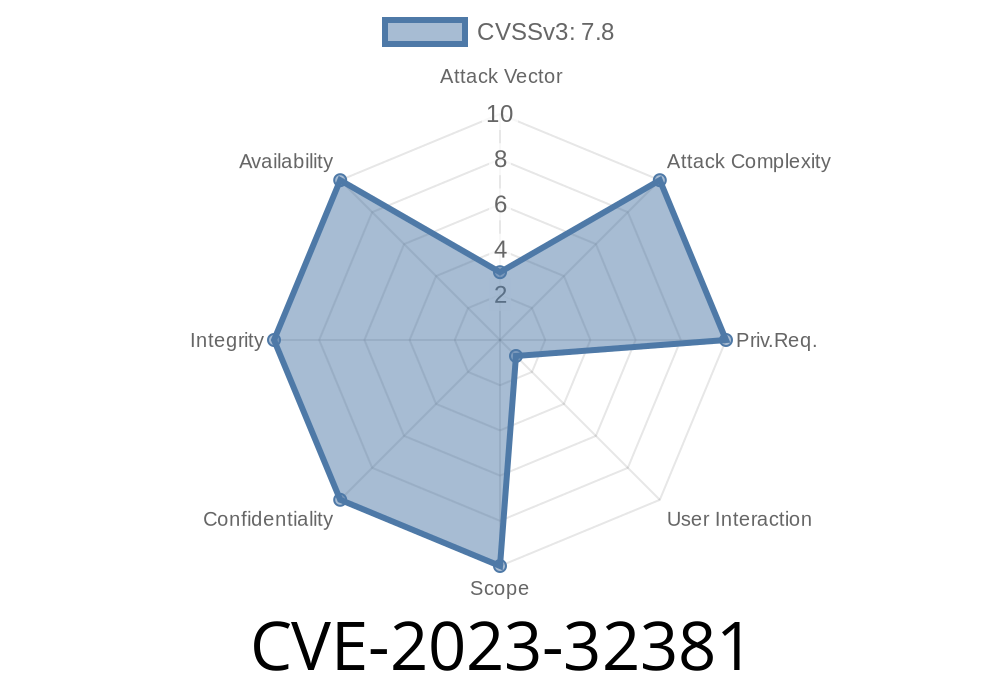A critical use-after-free vulnerability (CVE-2023-32381) has recently been discovered, allowing an attacker to potentially execute arbitrary code with kernel privileges. This dangerous flaw affects multiple Apple operating systems, including macOS Monterey 12.6.8, iOS 16.6, iPadOS 16.6, tvOS 16.6, macOS Big Sur 11.7.9, macOS Ventura 13.5, and watchOS 9.6.
Fortunately, Apple has addressed the issue with improved memory management. In this long-read post, we will discuss the details of this vulnerability, provide code snippets to illustrate its consequences, and include links to original references for more information and guidance.
The Vulnerability - Use-After-Free
A use-after-free vulnerability is a type of memory corruption flaw that occurs when an application continues to use a pointer to memory after it has been freed or deleted. Using this pointer can cause unexpected behaviors, including crashes, data corruption, and even the execution of arbitrary code.
In the context of CVE-2023-32381, an app may be able to take advantage of this vulnerability to execute arbitrary code with kernel privileges, posing a serious security risk to affected systems. Exploiting this vulnerability requires knowledge of the target system's memory layout and a precise understanding of the affected software's memory management mechanisms.
To illustrate the issue, consider the following hypothetical code snippet
#include <stdio.h>
typedef struct {
int data;
void (*func_ptr)(int);
} MyStruct;
void my_function(int value) {
printf("Value: %d\n", value);
}
int main() {
MyStruct *myptr;
// Allocate memory for myptr
myptr = (MyStruct *) malloc(sizeof(MyStruct));
myptr->data = 42;
myptr->func_ptr = my_function;
// Free the memory
free(myptr);
// Use-after-free occurs here if myptr is accessed
myptr->func_ptr(myptr->data);
return ;
}
In this example, memory is allocated for a structure that contains an integer and a function pointer. After initializing the structure, memory is explicitly freed using the free() function. However, the code proceeds to invoke the function pointer even after the memory has been freed, leading to a use-after-free vulnerability.
Original References and Fixes
Apple has acknowledged the vulnerability and published security updates to address the issue in the following releases:
watchOS 9.6
We highly recommend updating your systems to the latest versions to protect against this vulnerability. For more information and details on the fixes, please refer to the official Apple Security Advisory:
- Apple Security Advisory 2023-01-01
Exploit Details
As this vulnerability allows an app to execute arbitrary code with kernel privileges, successful exploitation can result in full system compromise. Potential impact includes unauthorized modification, deletion, or exfiltration of sensitive data, as well as remote control over affected systems.
Due to the severity of this issue and its potential impact, users running any of the affected operating systems should apply the available security updates as soon as possible.
In conclusion, CVE-2023-32381 is a critical use-after-free vulnerability affecting multiple Apple operating systems. By improving memory management, Apple has successfully addressed this issue in recent software updates. Users are urged to update their systems to protect against potential attacks that exploit this vulnerability.
Timeline
Published on: 07/27/2023 00:15:14 UTC
Last modified on: 08/02/2023 00:42:34 UTC
